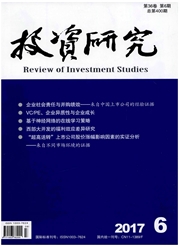

 中文摘要:
中文摘要:
本文建立了基于Williams(1938)的股票非预期收益定价模型,本文提出了两个新的度量变量,即表示股票每股收益增长的理性预期相联系的变量δEepst/Pt-1以及市场情绪变量URM,在此基础上,本文建立了多变量回归模型,并采用2002年1月至2008年12月间中国股票市场的有关交易数据、机构收益预测数据和财务数据,来检验理论模型和实证模型的预测,发现:(1)总风险与系统风险不能解释股票非预期收益,和Chambers等(2005)的结论相反,与非预期收益有关的总风险与系统风险也不能解释股票非预期收益。(2)当期非预期会计收益期初价格比epst/Pt-1、表示每股收益增长的理性预期相联系的变量δEepst/Pt-1以及市场情绪变量URM构成的三因素变量定价模型可以解释股票的非预期收益。
 英文摘要:
英文摘要:
We investigate the possibility whether the unexpected returns can be explained by total risk. New measures are introduced here to test a relation between current-period unexpected returns and measures of risk and unexpected earnings that incorporates revisions in forecasts of current-period earnings and market sentiment. We find little empirical support for a signifi- cant relation between unexpected return and total risk and inclusion of unexpected earnings that incorporates the two new variables, while the unexpected returns can be exactly explained by three variables of unexpected earnings-price ratio and revisions-price ratio in earnings forecasts of current-period and market sentiment.
 同期刊论文项目
同期刊论文项目
 同项目期刊论文
同项目期刊论文
 期刊信息
期刊信息
